GSBS6005: Strategic Marketing Management Plan for Aldi
VerifiedAdded on 2023/05/28
|10
|2805
|176
Report
AI Summary
This report presents a comprehensive marketing management plan for Aldi, addressing issues such as a static customer base, poor brand recognition, and lack of advertising. It outlines SMART marketing objectives for the next 12 months, including increasing sales, market share, and achieving excellent customer feedback. The plan details segmentation, targeting, and positioning strategies, focusing on both premium and low-income customers in suburban areas. It also discusses the appropriate marketing mix, emphasizing product quality, reasonable pricing, strategic placement, and effective promotion through both above-the-line and below-the-line methods. The report concludes that enhancing marketing activities is crucial for Aldi to compete effectively with rivals like Coles and Woolworths, ultimately improving brand recognition and expanding its customer base. Desklib provides students access to a wide array of solved assignments and resources.
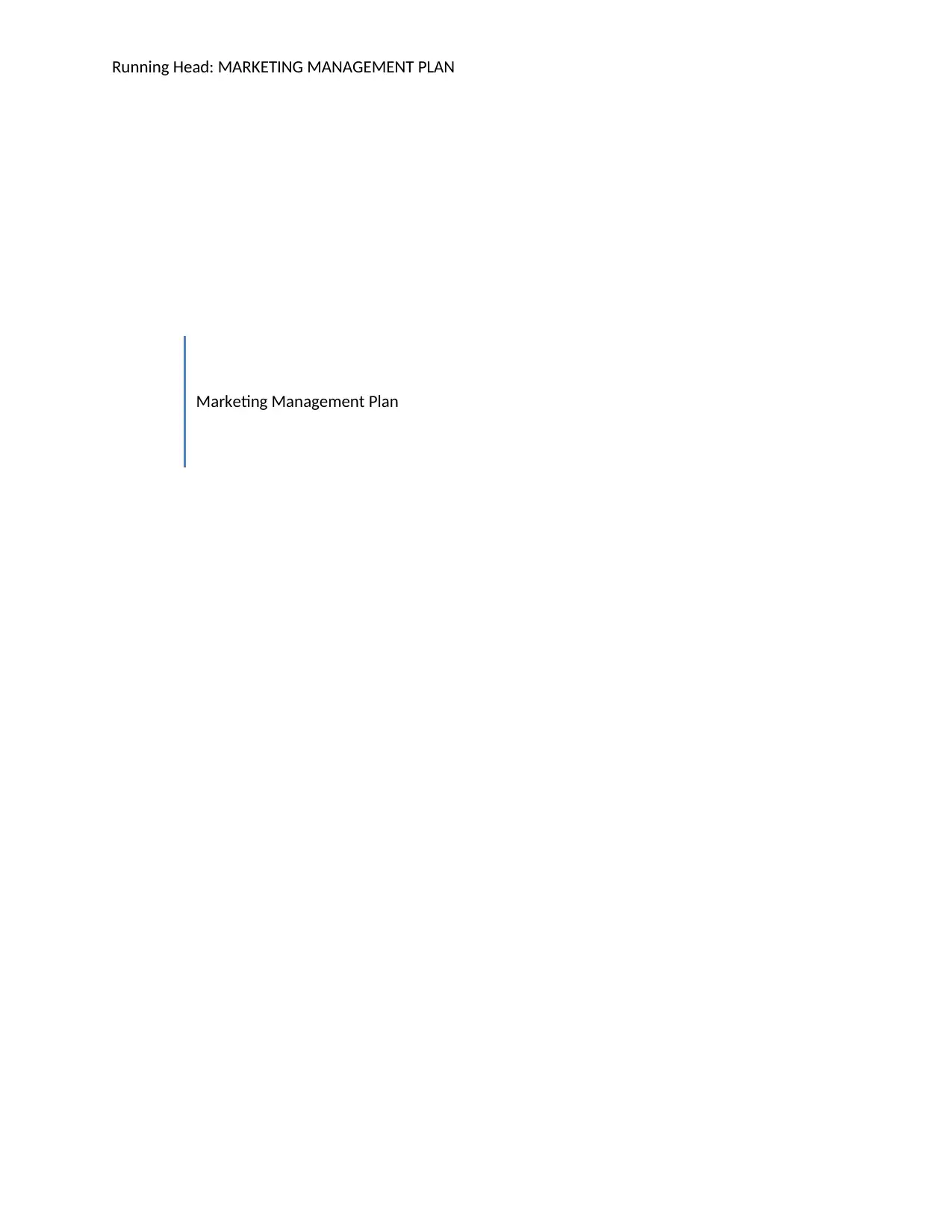
Running Head: MARKETING MANAGEMENT PLAN
Marketing Management Plan
Marketing Management Plan
Paraphrase This Document
Need a fresh take? Get an instant paraphrase of this document with our AI Paraphraser
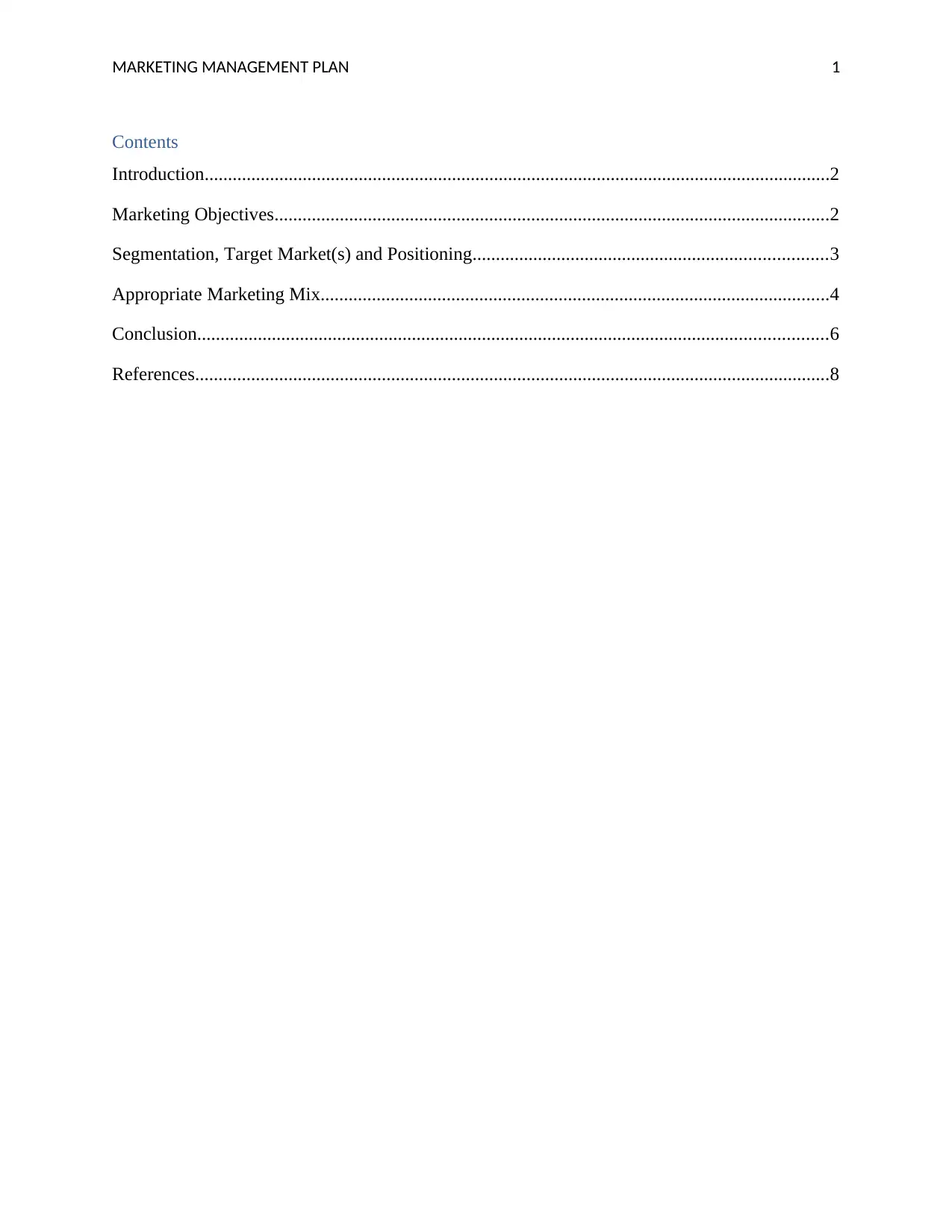
MARKETING MANAGEMENT PLAN 1
Contents
Introduction......................................................................................................................................2
Marketing Objectives.......................................................................................................................2
Segmentation, Target Market(s) and Positioning............................................................................3
Appropriate Marketing Mix.............................................................................................................4
Conclusion.......................................................................................................................................6
References........................................................................................................................................8
Contents
Introduction......................................................................................................................................2
Marketing Objectives.......................................................................................................................2
Segmentation, Target Market(s) and Positioning............................................................................3
Appropriate Marketing Mix.............................................................................................................4
Conclusion.......................................................................................................................................6
References........................................................................................................................................8
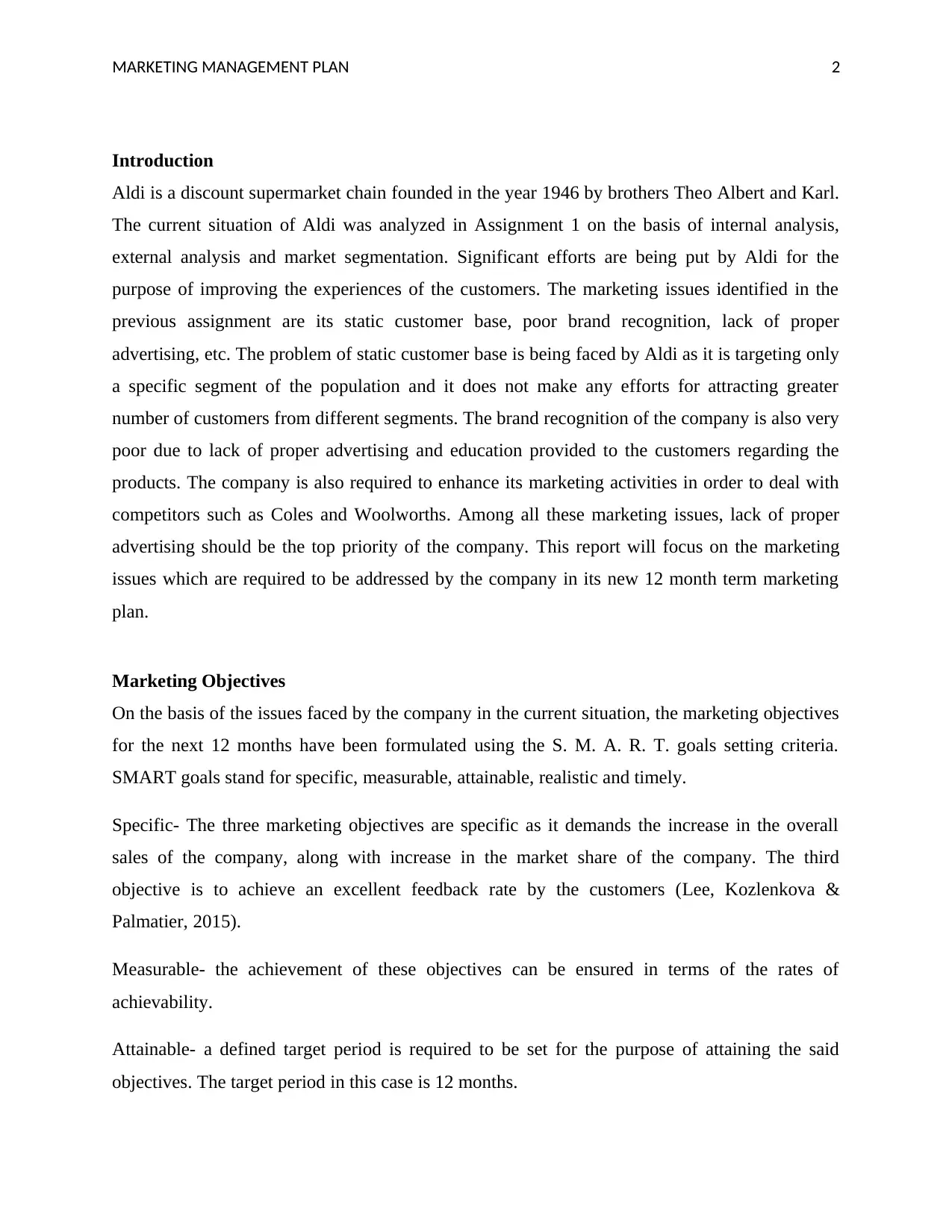
MARKETING MANAGEMENT PLAN 2
Introduction
Aldi is a discount supermarket chain founded in the year 1946 by brothers Theo Albert and Karl.
The current situation of Aldi was analyzed in Assignment 1 on the basis of internal analysis,
external analysis and market segmentation. Significant efforts are being put by Aldi for the
purpose of improving the experiences of the customers. The marketing issues identified in the
previous assignment are its static customer base, poor brand recognition, lack of proper
advertising, etc. The problem of static customer base is being faced by Aldi as it is targeting only
a specific segment of the population and it does not make any efforts for attracting greater
number of customers from different segments. The brand recognition of the company is also very
poor due to lack of proper advertising and education provided to the customers regarding the
products. The company is also required to enhance its marketing activities in order to deal with
competitors such as Coles and Woolworths. Among all these marketing issues, lack of proper
advertising should be the top priority of the company. This report will focus on the marketing
issues which are required to be addressed by the company in its new 12 month term marketing
plan.
Marketing Objectives
On the basis of the issues faced by the company in the current situation, the marketing objectives
for the next 12 months have been formulated using the S. M. A. R. T. goals setting criteria.
SMART goals stand for specific, measurable, attainable, realistic and timely.
Specific- The three marketing objectives are specific as it demands the increase in the overall
sales of the company, along with increase in the market share of the company. The third
objective is to achieve an excellent feedback rate by the customers (Lee, Kozlenkova &
Palmatier, 2015).
Measurable- the achievement of these objectives can be ensured in terms of the rates of
achievability.
Attainable- a defined target period is required to be set for the purpose of attaining the said
objectives. The target period in this case is 12 months.
Introduction
Aldi is a discount supermarket chain founded in the year 1946 by brothers Theo Albert and Karl.
The current situation of Aldi was analyzed in Assignment 1 on the basis of internal analysis,
external analysis and market segmentation. Significant efforts are being put by Aldi for the
purpose of improving the experiences of the customers. The marketing issues identified in the
previous assignment are its static customer base, poor brand recognition, lack of proper
advertising, etc. The problem of static customer base is being faced by Aldi as it is targeting only
a specific segment of the population and it does not make any efforts for attracting greater
number of customers from different segments. The brand recognition of the company is also very
poor due to lack of proper advertising and education provided to the customers regarding the
products. The company is also required to enhance its marketing activities in order to deal with
competitors such as Coles and Woolworths. Among all these marketing issues, lack of proper
advertising should be the top priority of the company. This report will focus on the marketing
issues which are required to be addressed by the company in its new 12 month term marketing
plan.
Marketing Objectives
On the basis of the issues faced by the company in the current situation, the marketing objectives
for the next 12 months have been formulated using the S. M. A. R. T. goals setting criteria.
SMART goals stand for specific, measurable, attainable, realistic and timely.
Specific- The three marketing objectives are specific as it demands the increase in the overall
sales of the company, along with increase in the market share of the company. The third
objective is to achieve an excellent feedback rate by the customers (Lee, Kozlenkova &
Palmatier, 2015).
Measurable- the achievement of these objectives can be ensured in terms of the rates of
achievability.
Attainable- a defined target period is required to be set for the purpose of attaining the said
objectives. The target period in this case is 12 months.
⊘ This is a preview!⊘
Do you want full access?
Subscribe today to unlock all pages.

Trusted by 1+ million students worldwide
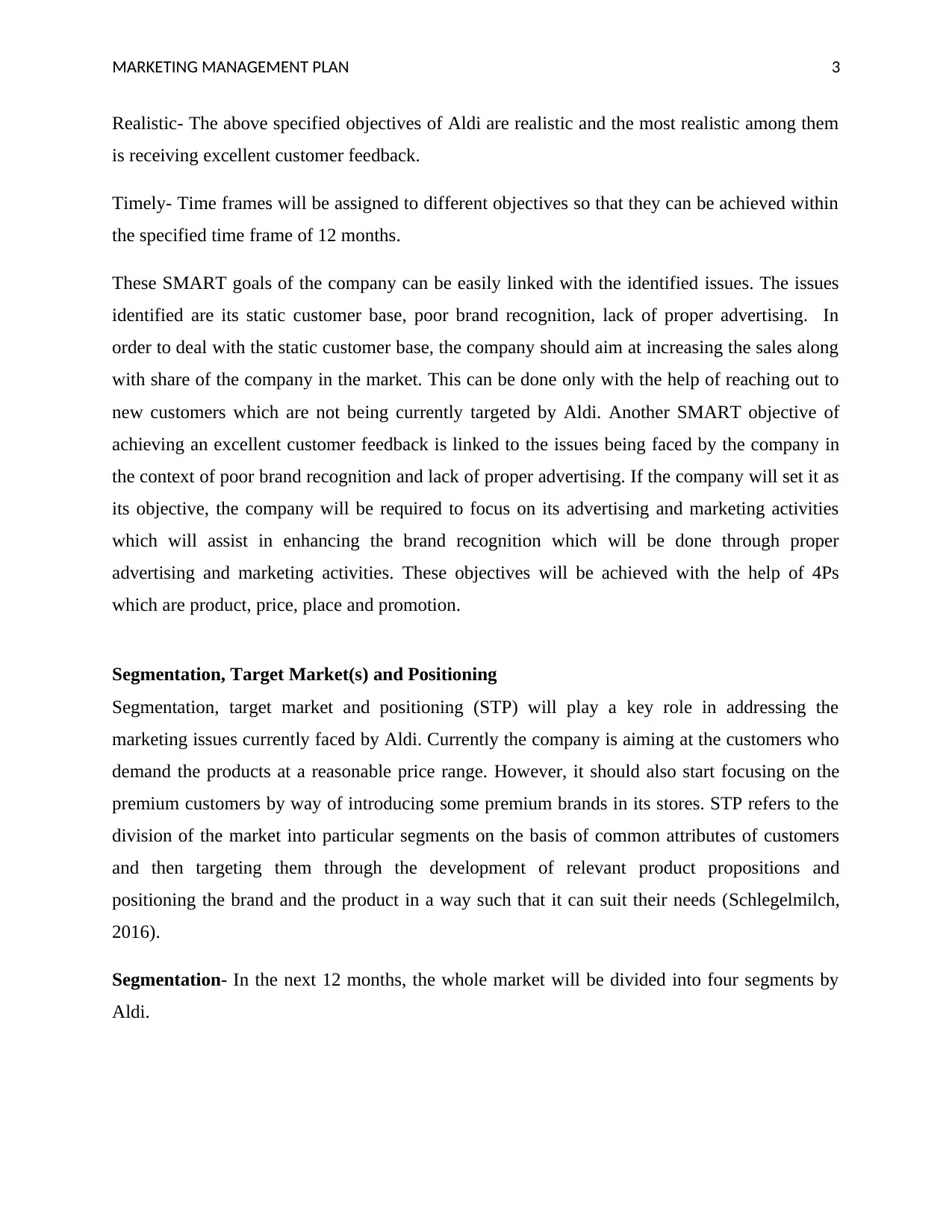
MARKETING MANAGEMENT PLAN 3
Realistic- The above specified objectives of Aldi are realistic and the most realistic among them
is receiving excellent customer feedback.
Timely- Time frames will be assigned to different objectives so that they can be achieved within
the specified time frame of 12 months.
These SMART goals of the company can be easily linked with the identified issues. The issues
identified are its static customer base, poor brand recognition, lack of proper advertising. In
order to deal with the static customer base, the company should aim at increasing the sales along
with share of the company in the market. This can be done only with the help of reaching out to
new customers which are not being currently targeted by Aldi. Another SMART objective of
achieving an excellent customer feedback is linked to the issues being faced by the company in
the context of poor brand recognition and lack of proper advertising. If the company will set it as
its objective, the company will be required to focus on its advertising and marketing activities
which will assist in enhancing the brand recognition which will be done through proper
advertising and marketing activities. These objectives will be achieved with the help of 4Ps
which are product, price, place and promotion.
Segmentation, Target Market(s) and Positioning
Segmentation, target market and positioning (STP) will play a key role in addressing the
marketing issues currently faced by Aldi. Currently the company is aiming at the customers who
demand the products at a reasonable price range. However, it should also start focusing on the
premium customers by way of introducing some premium brands in its stores. STP refers to the
division of the market into particular segments on the basis of common attributes of customers
and then targeting them through the development of relevant product propositions and
positioning the brand and the product in a way such that it can suit their needs (Schlegelmilch,
2016).
Segmentation- In the next 12 months, the whole market will be divided into four segments by
Aldi.
Realistic- The above specified objectives of Aldi are realistic and the most realistic among them
is receiving excellent customer feedback.
Timely- Time frames will be assigned to different objectives so that they can be achieved within
the specified time frame of 12 months.
These SMART goals of the company can be easily linked with the identified issues. The issues
identified are its static customer base, poor brand recognition, lack of proper advertising. In
order to deal with the static customer base, the company should aim at increasing the sales along
with share of the company in the market. This can be done only with the help of reaching out to
new customers which are not being currently targeted by Aldi. Another SMART objective of
achieving an excellent customer feedback is linked to the issues being faced by the company in
the context of poor brand recognition and lack of proper advertising. If the company will set it as
its objective, the company will be required to focus on its advertising and marketing activities
which will assist in enhancing the brand recognition which will be done through proper
advertising and marketing activities. These objectives will be achieved with the help of 4Ps
which are product, price, place and promotion.
Segmentation, Target Market(s) and Positioning
Segmentation, target market and positioning (STP) will play a key role in addressing the
marketing issues currently faced by Aldi. Currently the company is aiming at the customers who
demand the products at a reasonable price range. However, it should also start focusing on the
premium customers by way of introducing some premium brands in its stores. STP refers to the
division of the market into particular segments on the basis of common attributes of customers
and then targeting them through the development of relevant product propositions and
positioning the brand and the product in a way such that it can suit their needs (Schlegelmilch,
2016).
Segmentation- In the next 12 months, the whole market will be divided into four segments by
Aldi.
Paraphrase This Document
Need a fresh take? Get an instant paraphrase of this document with our AI Paraphraser
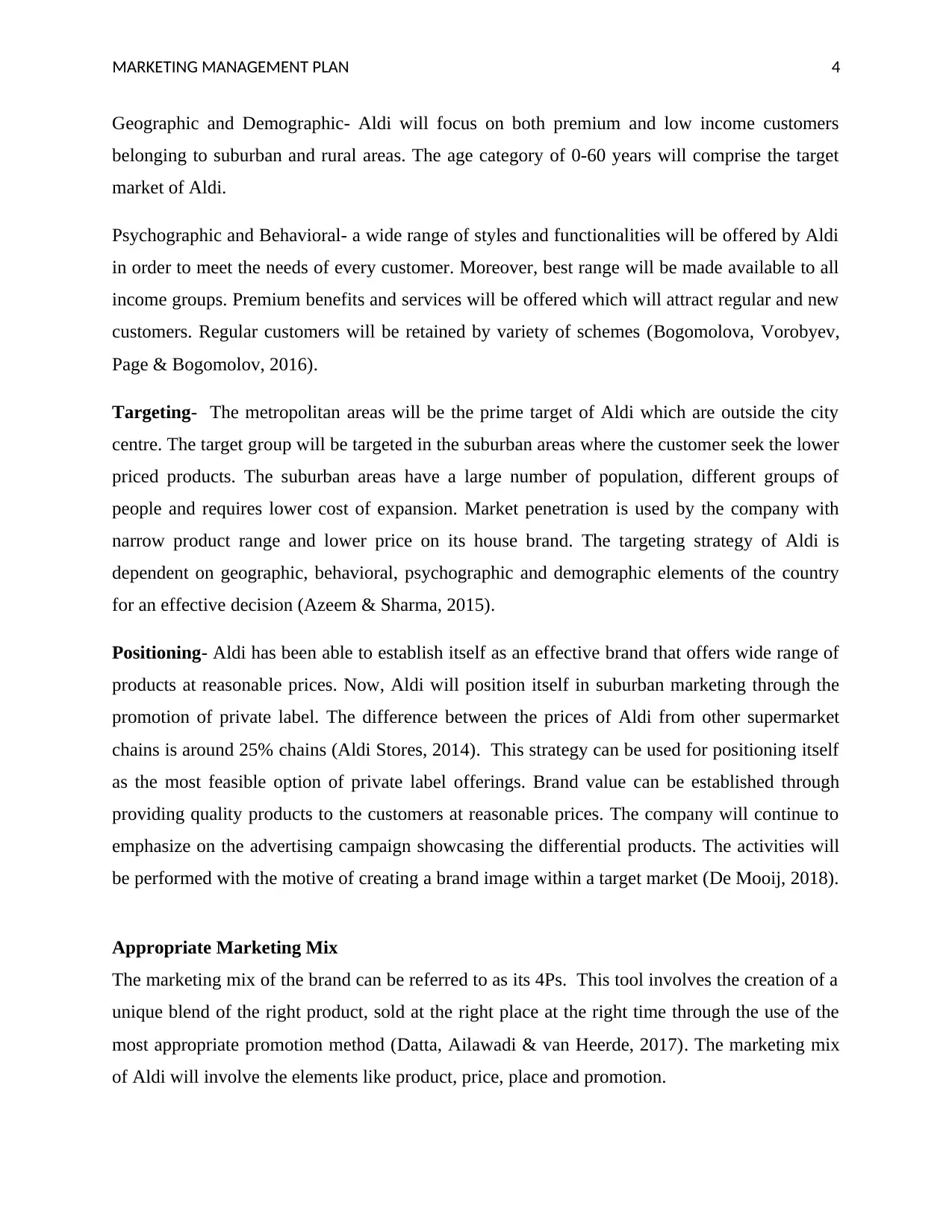
MARKETING MANAGEMENT PLAN 4
Geographic and Demographic- Aldi will focus on both premium and low income customers
belonging to suburban and rural areas. The age category of 0-60 years will comprise the target
market of Aldi.
Psychographic and Behavioral- a wide range of styles and functionalities will be offered by Aldi
in order to meet the needs of every customer. Moreover, best range will be made available to all
income groups. Premium benefits and services will be offered which will attract regular and new
customers. Regular customers will be retained by variety of schemes (Bogomolova, Vorobyev,
Page & Bogomolov, 2016).
Targeting- The metropolitan areas will be the prime target of Aldi which are outside the city
centre. The target group will be targeted in the suburban areas where the customer seek the lower
priced products. The suburban areas have a large number of population, different groups of
people and requires lower cost of expansion. Market penetration is used by the company with
narrow product range and lower price on its house brand. The targeting strategy of Aldi is
dependent on geographic, behavioral, psychographic and demographic elements of the country
for an effective decision (Azeem & Sharma, 2015).
Positioning- Aldi has been able to establish itself as an effective brand that offers wide range of
products at reasonable prices. Now, Aldi will position itself in suburban marketing through the
promotion of private label. The difference between the prices of Aldi from other supermarket
chains is around 25% chains (Aldi Stores, 2014). This strategy can be used for positioning itself
as the most feasible option of private label offerings. Brand value can be established through
providing quality products to the customers at reasonable prices. The company will continue to
emphasize on the advertising campaign showcasing the differential products. The activities will
be performed with the motive of creating a brand image within a target market (De Mooij, 2018).
Appropriate Marketing Mix
The marketing mix of the brand can be referred to as its 4Ps. This tool involves the creation of a
unique blend of the right product, sold at the right place at the right time through the use of the
most appropriate promotion method (Datta, Ailawadi & van Heerde, 2017). The marketing mix
of Aldi will involve the elements like product, price, place and promotion.
Geographic and Demographic- Aldi will focus on both premium and low income customers
belonging to suburban and rural areas. The age category of 0-60 years will comprise the target
market of Aldi.
Psychographic and Behavioral- a wide range of styles and functionalities will be offered by Aldi
in order to meet the needs of every customer. Moreover, best range will be made available to all
income groups. Premium benefits and services will be offered which will attract regular and new
customers. Regular customers will be retained by variety of schemes (Bogomolova, Vorobyev,
Page & Bogomolov, 2016).
Targeting- The metropolitan areas will be the prime target of Aldi which are outside the city
centre. The target group will be targeted in the suburban areas where the customer seek the lower
priced products. The suburban areas have a large number of population, different groups of
people and requires lower cost of expansion. Market penetration is used by the company with
narrow product range and lower price on its house brand. The targeting strategy of Aldi is
dependent on geographic, behavioral, psychographic and demographic elements of the country
for an effective decision (Azeem & Sharma, 2015).
Positioning- Aldi has been able to establish itself as an effective brand that offers wide range of
products at reasonable prices. Now, Aldi will position itself in suburban marketing through the
promotion of private label. The difference between the prices of Aldi from other supermarket
chains is around 25% chains (Aldi Stores, 2014). This strategy can be used for positioning itself
as the most feasible option of private label offerings. Brand value can be established through
providing quality products to the customers at reasonable prices. The company will continue to
emphasize on the advertising campaign showcasing the differential products. The activities will
be performed with the motive of creating a brand image within a target market (De Mooij, 2018).
Appropriate Marketing Mix
The marketing mix of the brand can be referred to as its 4Ps. This tool involves the creation of a
unique blend of the right product, sold at the right place at the right time through the use of the
most appropriate promotion method (Datta, Ailawadi & van Heerde, 2017). The marketing mix
of Aldi will involve the elements like product, price, place and promotion.
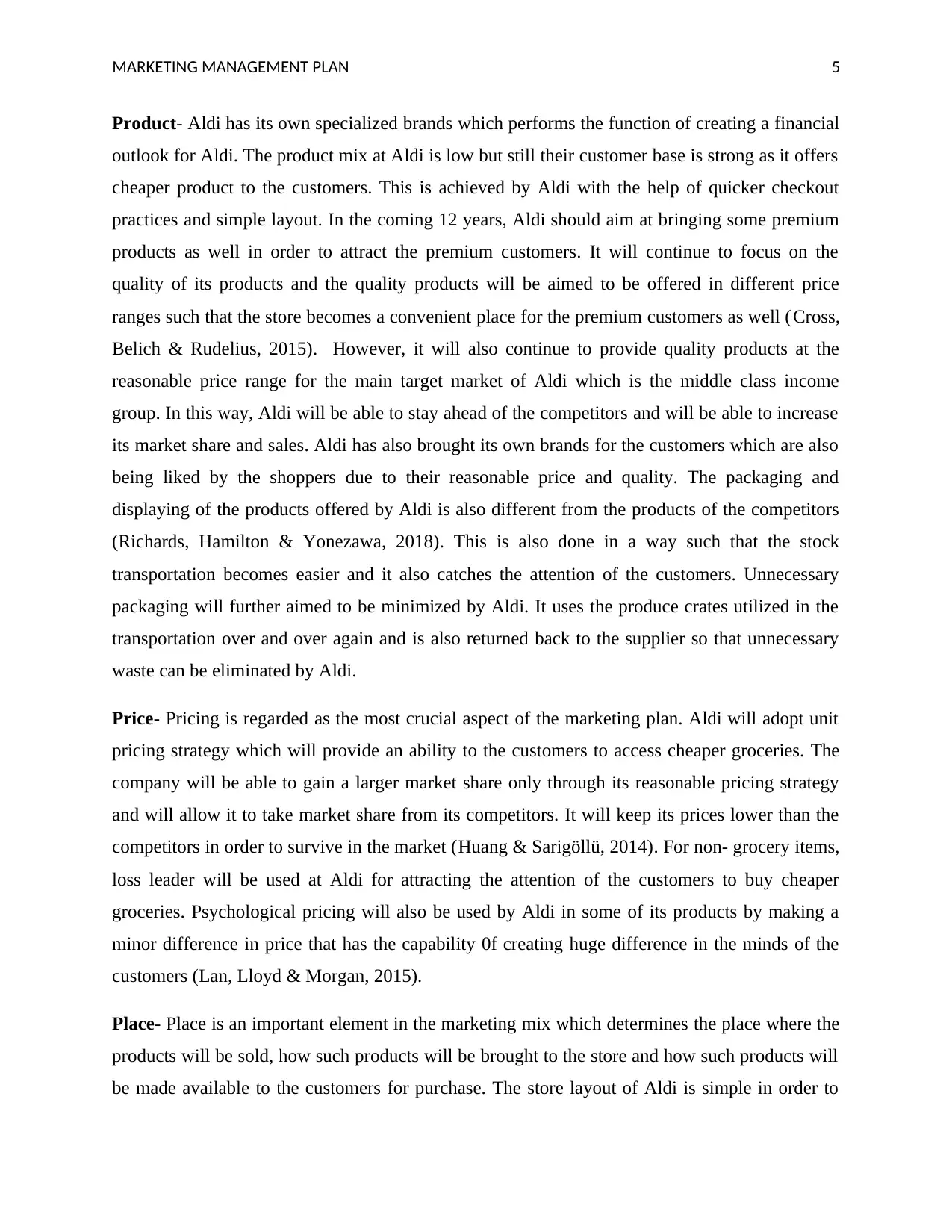
MARKETING MANAGEMENT PLAN 5
Product- Aldi has its own specialized brands which performs the function of creating a financial
outlook for Aldi. The product mix at Aldi is low but still their customer base is strong as it offers
cheaper product to the customers. This is achieved by Aldi with the help of quicker checkout
practices and simple layout. In the coming 12 years, Aldi should aim at bringing some premium
products as well in order to attract the premium customers. It will continue to focus on the
quality of its products and the quality products will be aimed to be offered in different price
ranges such that the store becomes a convenient place for the premium customers as well (Cross,
Belich & Rudelius, 2015). However, it will also continue to provide quality products at the
reasonable price range for the main target market of Aldi which is the middle class income
group. In this way, Aldi will be able to stay ahead of the competitors and will be able to increase
its market share and sales. Aldi has also brought its own brands for the customers which are also
being liked by the shoppers due to their reasonable price and quality. The packaging and
displaying of the products offered by Aldi is also different from the products of the competitors
(Richards, Hamilton & Yonezawa, 2018). This is also done in a way such that the stock
transportation becomes easier and it also catches the attention of the customers. Unnecessary
packaging will further aimed to be minimized by Aldi. It uses the produce crates utilized in the
transportation over and over again and is also returned back to the supplier so that unnecessary
waste can be eliminated by Aldi.
Price- Pricing is regarded as the most crucial aspect of the marketing plan. Aldi will adopt unit
pricing strategy which will provide an ability to the customers to access cheaper groceries. The
company will be able to gain a larger market share only through its reasonable pricing strategy
and will allow it to take market share from its competitors. It will keep its prices lower than the
competitors in order to survive in the market (Huang & Sarigöllü, 2014). For non- grocery items,
loss leader will be used at Aldi for attracting the attention of the customers to buy cheaper
groceries. Psychological pricing will also be used by Aldi in some of its products by making a
minor difference in price that has the capability 0f creating huge difference in the minds of the
customers (Lan, Lloyd & Morgan, 2015).
Place- Place is an important element in the marketing mix which determines the place where the
products will be sold, how such products will be brought to the store and how such products will
be made available to the customers for purchase. The store layout of Aldi is simple in order to
Product- Aldi has its own specialized brands which performs the function of creating a financial
outlook for Aldi. The product mix at Aldi is low but still their customer base is strong as it offers
cheaper product to the customers. This is achieved by Aldi with the help of quicker checkout
practices and simple layout. In the coming 12 years, Aldi should aim at bringing some premium
products as well in order to attract the premium customers. It will continue to focus on the
quality of its products and the quality products will be aimed to be offered in different price
ranges such that the store becomes a convenient place for the premium customers as well (Cross,
Belich & Rudelius, 2015). However, it will also continue to provide quality products at the
reasonable price range for the main target market of Aldi which is the middle class income
group. In this way, Aldi will be able to stay ahead of the competitors and will be able to increase
its market share and sales. Aldi has also brought its own brands for the customers which are also
being liked by the shoppers due to their reasonable price and quality. The packaging and
displaying of the products offered by Aldi is also different from the products of the competitors
(Richards, Hamilton & Yonezawa, 2018). This is also done in a way such that the stock
transportation becomes easier and it also catches the attention of the customers. Unnecessary
packaging will further aimed to be minimized by Aldi. It uses the produce crates utilized in the
transportation over and over again and is also returned back to the supplier so that unnecessary
waste can be eliminated by Aldi.
Price- Pricing is regarded as the most crucial aspect of the marketing plan. Aldi will adopt unit
pricing strategy which will provide an ability to the customers to access cheaper groceries. The
company will be able to gain a larger market share only through its reasonable pricing strategy
and will allow it to take market share from its competitors. It will keep its prices lower than the
competitors in order to survive in the market (Huang & Sarigöllü, 2014). For non- grocery items,
loss leader will be used at Aldi for attracting the attention of the customers to buy cheaper
groceries. Psychological pricing will also be used by Aldi in some of its products by making a
minor difference in price that has the capability 0f creating huge difference in the minds of the
customers (Lan, Lloyd & Morgan, 2015).
Place- Place is an important element in the marketing mix which determines the place where the
products will be sold, how such products will be brought to the store and how such products will
be made available to the customers for purchase. The store layout of Aldi is simple in order to
⊘ This is a preview!⊘
Do you want full access?
Subscribe today to unlock all pages.

Trusted by 1+ million students worldwide
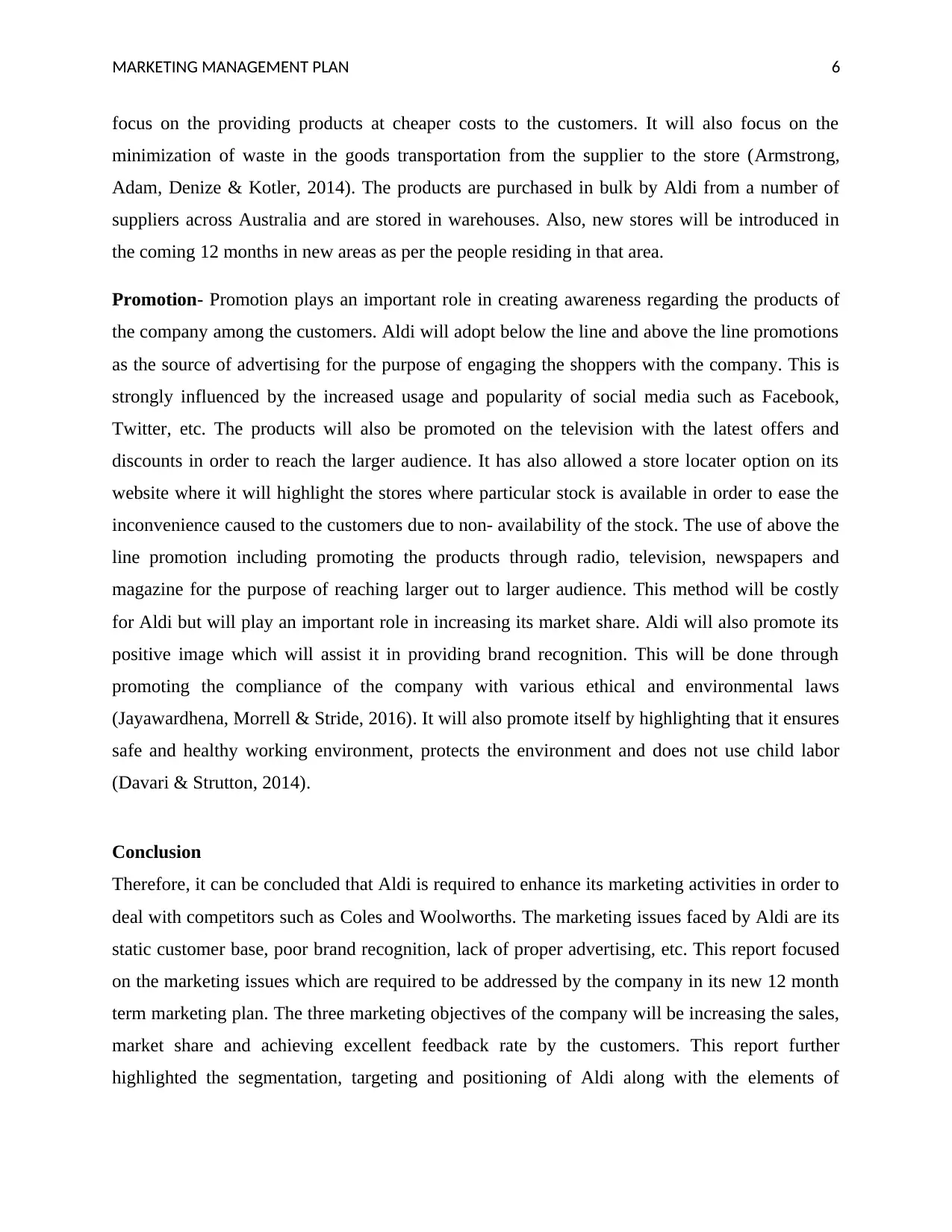
MARKETING MANAGEMENT PLAN 6
focus on the providing products at cheaper costs to the customers. It will also focus on the
minimization of waste in the goods transportation from the supplier to the store (Armstrong,
Adam, Denize & Kotler, 2014). The products are purchased in bulk by Aldi from a number of
suppliers across Australia and are stored in warehouses. Also, new stores will be introduced in
the coming 12 months in new areas as per the people residing in that area.
Promotion- Promotion plays an important role in creating awareness regarding the products of
the company among the customers. Aldi will adopt below the line and above the line promotions
as the source of advertising for the purpose of engaging the shoppers with the company. This is
strongly influenced by the increased usage and popularity of social media such as Facebook,
Twitter, etc. The products will also be promoted on the television with the latest offers and
discounts in order to reach the larger audience. It has also allowed a store locater option on its
website where it will highlight the stores where particular stock is available in order to ease the
inconvenience caused to the customers due to non- availability of the stock. The use of above the
line promotion including promoting the products through radio, television, newspapers and
magazine for the purpose of reaching larger out to larger audience. This method will be costly
for Aldi but will play an important role in increasing its market share. Aldi will also promote its
positive image which will assist it in providing brand recognition. This will be done through
promoting the compliance of the company with various ethical and environmental laws
(Jayawardhena, Morrell & Stride, 2016). It will also promote itself by highlighting that it ensures
safe and healthy working environment, protects the environment and does not use child labor
(Davari & Strutton, 2014).
Conclusion
Therefore, it can be concluded that Aldi is required to enhance its marketing activities in order to
deal with competitors such as Coles and Woolworths. The marketing issues faced by Aldi are its
static customer base, poor brand recognition, lack of proper advertising, etc. This report focused
on the marketing issues which are required to be addressed by the company in its new 12 month
term marketing plan. The three marketing objectives of the company will be increasing the sales,
market share and achieving excellent feedback rate by the customers. This report further
highlighted the segmentation, targeting and positioning of Aldi along with the elements of
focus on the providing products at cheaper costs to the customers. It will also focus on the
minimization of waste in the goods transportation from the supplier to the store (Armstrong,
Adam, Denize & Kotler, 2014). The products are purchased in bulk by Aldi from a number of
suppliers across Australia and are stored in warehouses. Also, new stores will be introduced in
the coming 12 months in new areas as per the people residing in that area.
Promotion- Promotion plays an important role in creating awareness regarding the products of
the company among the customers. Aldi will adopt below the line and above the line promotions
as the source of advertising for the purpose of engaging the shoppers with the company. This is
strongly influenced by the increased usage and popularity of social media such as Facebook,
Twitter, etc. The products will also be promoted on the television with the latest offers and
discounts in order to reach the larger audience. It has also allowed a store locater option on its
website where it will highlight the stores where particular stock is available in order to ease the
inconvenience caused to the customers due to non- availability of the stock. The use of above the
line promotion including promoting the products through radio, television, newspapers and
magazine for the purpose of reaching larger out to larger audience. This method will be costly
for Aldi but will play an important role in increasing its market share. Aldi will also promote its
positive image which will assist it in providing brand recognition. This will be done through
promoting the compliance of the company with various ethical and environmental laws
(Jayawardhena, Morrell & Stride, 2016). It will also promote itself by highlighting that it ensures
safe and healthy working environment, protects the environment and does not use child labor
(Davari & Strutton, 2014).
Conclusion
Therefore, it can be concluded that Aldi is required to enhance its marketing activities in order to
deal with competitors such as Coles and Woolworths. The marketing issues faced by Aldi are its
static customer base, poor brand recognition, lack of proper advertising, etc. This report focused
on the marketing issues which are required to be addressed by the company in its new 12 month
term marketing plan. The three marketing objectives of the company will be increasing the sales,
market share and achieving excellent feedback rate by the customers. This report further
highlighted the segmentation, targeting and positioning of Aldi along with the elements of
Paraphrase This Document
Need a fresh take? Get an instant paraphrase of this document with our AI Paraphraser
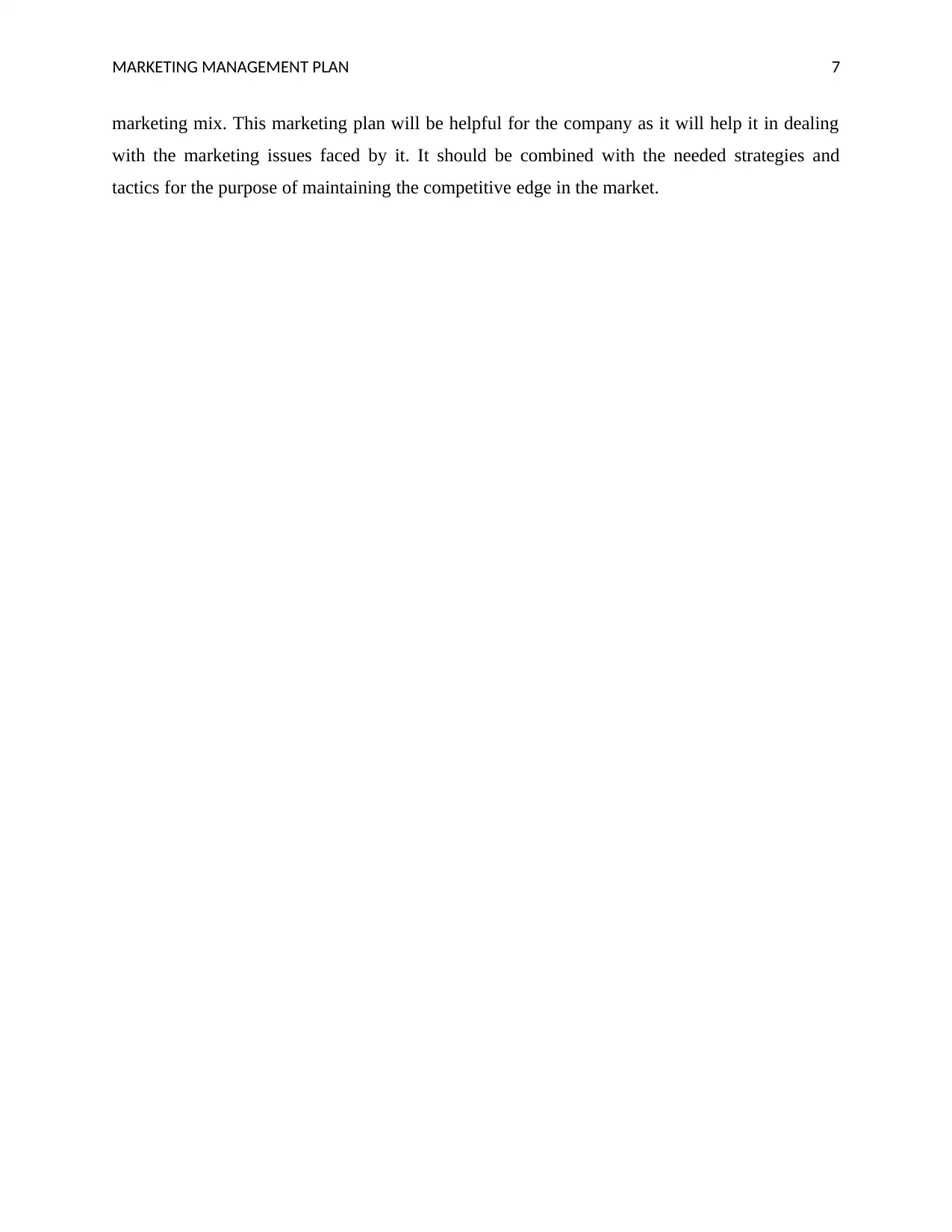
MARKETING MANAGEMENT PLAN 7
marketing mix. This marketing plan will be helpful for the company as it will help it in dealing
with the marketing issues faced by it. It should be combined with the needed strategies and
tactics for the purpose of maintaining the competitive edge in the market.
marketing mix. This marketing plan will be helpful for the company as it will help it in dealing
with the marketing issues faced by it. It should be combined with the needed strategies and
tactics for the purpose of maintaining the competitive edge in the market.
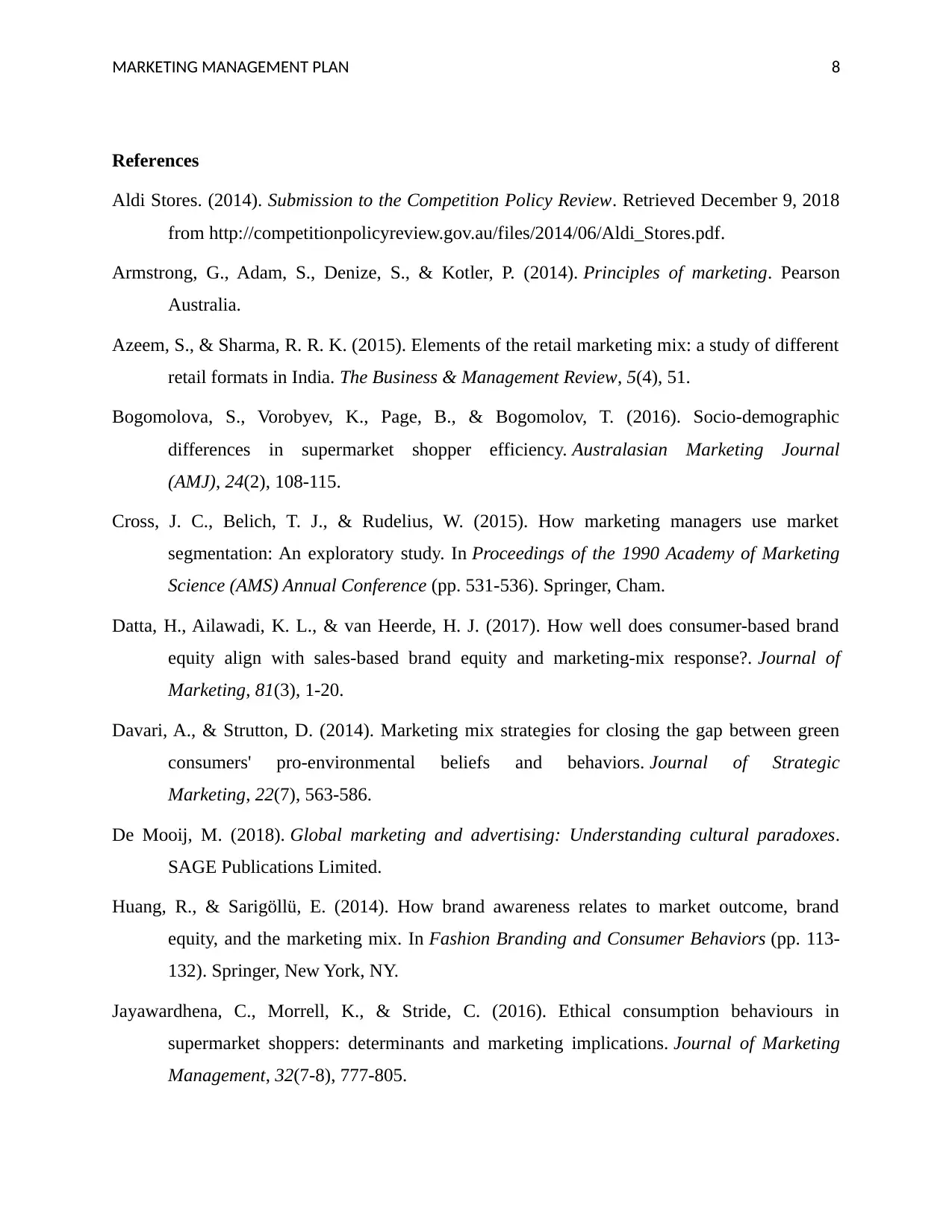
MARKETING MANAGEMENT PLAN 8
References
Aldi Stores. (2014). Submission to the Competition Policy Review. Retrieved December 9, 2018
from http://competitionpolicyreview.gov.au/files/2014/06/Aldi_Stores.pdf.
Armstrong, G., Adam, S., Denize, S., & Kotler, P. (2014). Principles of marketing. Pearson
Australia.
Azeem, S., & Sharma, R. R. K. (2015). Elements of the retail marketing mix: a study of different
retail formats in India. The Business & Management Review, 5(4), 51.
Bogomolova, S., Vorobyev, K., Page, B., & Bogomolov, T. (2016). Socio-demographic
differences in supermarket shopper efficiency. Australasian Marketing Journal
(AMJ), 24(2), 108-115.
Cross, J. C., Belich, T. J., & Rudelius, W. (2015). How marketing managers use market
segmentation: An exploratory study. In Proceedings of the 1990 Academy of Marketing
Science (AMS) Annual Conference (pp. 531-536). Springer, Cham.
Datta, H., Ailawadi, K. L., & van Heerde, H. J. (2017). How well does consumer-based brand
equity align with sales-based brand equity and marketing-mix response?. Journal of
Marketing, 81(3), 1-20.
Davari, A., & Strutton, D. (2014). Marketing mix strategies for closing the gap between green
consumers' pro-environmental beliefs and behaviors. Journal of Strategic
Marketing, 22(7), 563-586.
De Mooij, M. (2018). Global marketing and advertising: Understanding cultural paradoxes.
SAGE Publications Limited.
Huang, R., & Sarigöllü, E. (2014). How brand awareness relates to market outcome, brand
equity, and the marketing mix. In Fashion Branding and Consumer Behaviors (pp. 113-
132). Springer, New York, NY.
Jayawardhena, C., Morrell, K., & Stride, C. (2016). Ethical consumption behaviours in
supermarket shoppers: determinants and marketing implications. Journal of Marketing
Management, 32(7-8), 777-805.
References
Aldi Stores. (2014). Submission to the Competition Policy Review. Retrieved December 9, 2018
from http://competitionpolicyreview.gov.au/files/2014/06/Aldi_Stores.pdf.
Armstrong, G., Adam, S., Denize, S., & Kotler, P. (2014). Principles of marketing. Pearson
Australia.
Azeem, S., & Sharma, R. R. K. (2015). Elements of the retail marketing mix: a study of different
retail formats in India. The Business & Management Review, 5(4), 51.
Bogomolova, S., Vorobyev, K., Page, B., & Bogomolov, T. (2016). Socio-demographic
differences in supermarket shopper efficiency. Australasian Marketing Journal
(AMJ), 24(2), 108-115.
Cross, J. C., Belich, T. J., & Rudelius, W. (2015). How marketing managers use market
segmentation: An exploratory study. In Proceedings of the 1990 Academy of Marketing
Science (AMS) Annual Conference (pp. 531-536). Springer, Cham.
Datta, H., Ailawadi, K. L., & van Heerde, H. J. (2017). How well does consumer-based brand
equity align with sales-based brand equity and marketing-mix response?. Journal of
Marketing, 81(3), 1-20.
Davari, A., & Strutton, D. (2014). Marketing mix strategies for closing the gap between green
consumers' pro-environmental beliefs and behaviors. Journal of Strategic
Marketing, 22(7), 563-586.
De Mooij, M. (2018). Global marketing and advertising: Understanding cultural paradoxes.
SAGE Publications Limited.
Huang, R., & Sarigöllü, E. (2014). How brand awareness relates to market outcome, brand
equity, and the marketing mix. In Fashion Branding and Consumer Behaviors (pp. 113-
132). Springer, New York, NY.
Jayawardhena, C., Morrell, K., & Stride, C. (2016). Ethical consumption behaviours in
supermarket shoppers: determinants and marketing implications. Journal of Marketing
Management, 32(7-8), 777-805.
⊘ This is a preview!⊘
Do you want full access?
Subscribe today to unlock all pages.

Trusted by 1+ million students worldwide
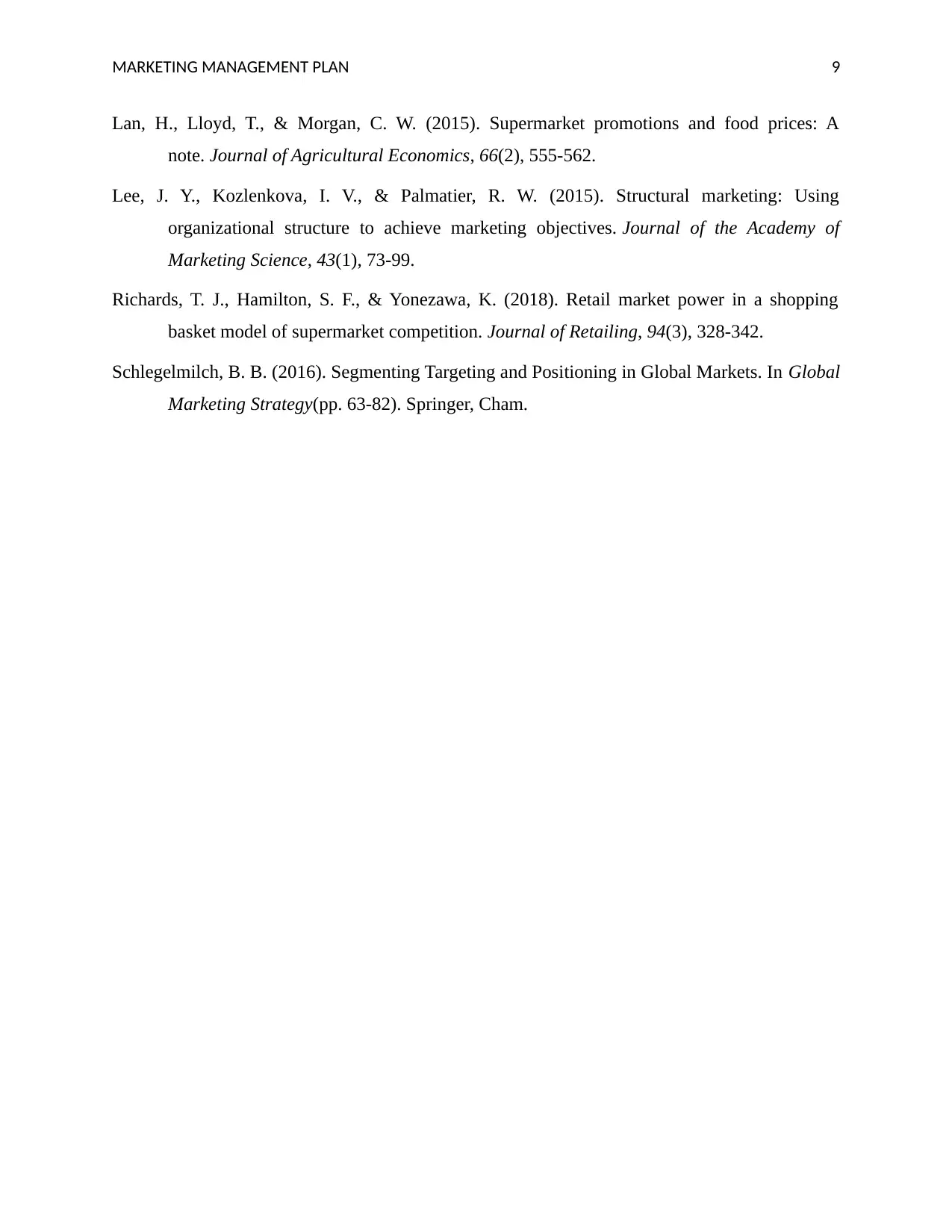
MARKETING MANAGEMENT PLAN 9
Lan, H., Lloyd, T., & Morgan, C. W. (2015). Supermarket promotions and food prices: A
note. Journal of Agricultural Economics, 66(2), 555-562.
Lee, J. Y., Kozlenkova, I. V., & Palmatier, R. W. (2015). Structural marketing: Using
organizational structure to achieve marketing objectives. Journal of the Academy of
Marketing Science, 43(1), 73-99.
Richards, T. J., Hamilton, S. F., & Yonezawa, K. (2018). Retail market power in a shopping
basket model of supermarket competition. Journal of Retailing, 94(3), 328-342.
Schlegelmilch, B. B. (2016). Segmenting Targeting and Positioning in Global Markets. In Global
Marketing Strategy(pp. 63-82). Springer, Cham.
Lan, H., Lloyd, T., & Morgan, C. W. (2015). Supermarket promotions and food prices: A
note. Journal of Agricultural Economics, 66(2), 555-562.
Lee, J. Y., Kozlenkova, I. V., & Palmatier, R. W. (2015). Structural marketing: Using
organizational structure to achieve marketing objectives. Journal of the Academy of
Marketing Science, 43(1), 73-99.
Richards, T. J., Hamilton, S. F., & Yonezawa, K. (2018). Retail market power in a shopping
basket model of supermarket competition. Journal of Retailing, 94(3), 328-342.
Schlegelmilch, B. B. (2016). Segmenting Targeting and Positioning in Global Markets. In Global
Marketing Strategy(pp. 63-82). Springer, Cham.
1 out of 10
Related Documents
Your All-in-One AI-Powered Toolkit for Academic Success.
+13062052269
info@desklib.com
Available 24*7 on WhatsApp / Email
![[object Object]](/_next/static/media/star-bottom.7253800d.svg)
Unlock your academic potential
Copyright © 2020–2025 A2Z Services. All Rights Reserved. Developed and managed by ZUCOL.





